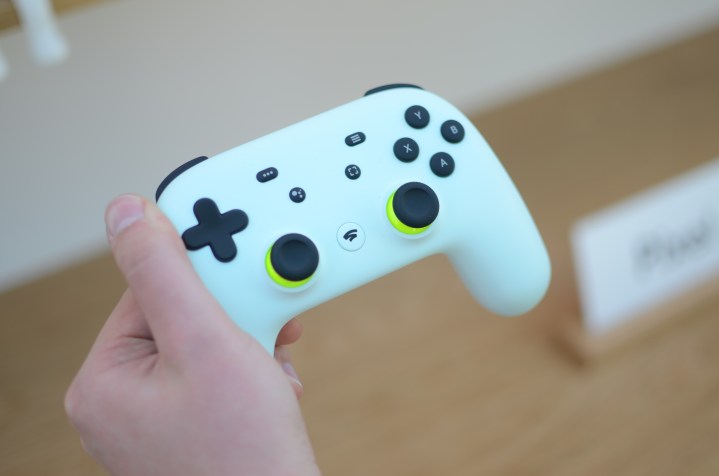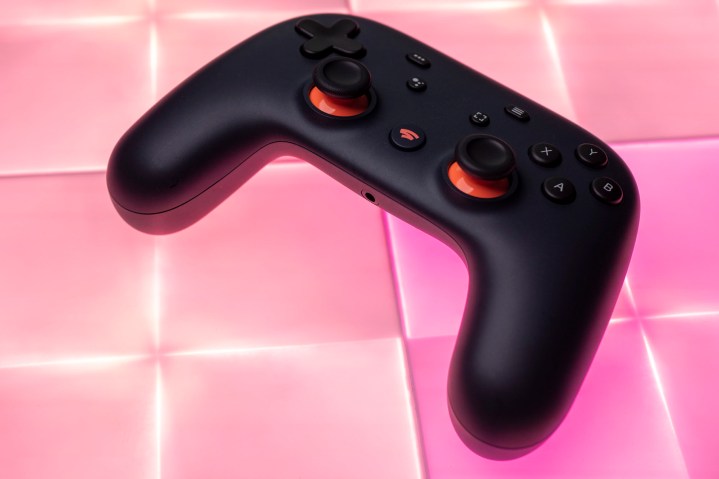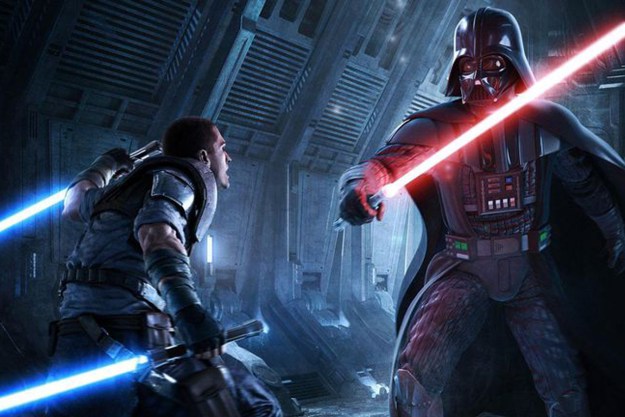Google Stadia, Xbox Game Pass, and PlayStation Now have introduced a gaming term that would’ve been completely foreign a decade ago: Cloud gaming. The premise is simple. Instead of buying a console and a disc, you can stream a game to any display you own, a bit like Netflix. But what is cloud gaming, exactly? And more importantly, how does it work?
- What is cloud gaming?
- How does cloud gaming work?
- How long has cloud gaming been around?
- Why is cloud gaming becoming popular now?
- Who are the front runners of cloud gaming?
- Which cloud gaming service is the best option?
- What is the difference between a game subscription service and a game-streaming service?
We’ve rounded up the rocky origins, an explanation of how the tech works, and the different platforms available today to bring you everything you need to know about cloud gaming.
Further reading
- I used cloud gaming for a month. Here’s what happened
- The best PS Now games
- The best games on Google Stadia
What is cloud gaming?
Cloud gaming is a method of playing video games using remote servers in data centers. There’s no need to download and install games on a PC or console. Instead, streaming services require a reliable internet connection to send gaming information to an app or browser installed on the recipient device. The game is rendered and played on the remote server, but you see and interact with everything locally on your device.
It’s just like Netflix or any other streaming platform. The only difference is that the server where the video stream is coming from can also pick up and react to your inputs. That means you don’t need a beefy RTX 30-series graphics card or a new Xbox Series X or PlayStation 5. With cloud gaming, all you need is a reliable internet connection.
That opens up a lot of possibilities. You can grab a phone clip and play the latest AAA games on your phone or boot up a cloud gaming app on a Chromebook for some highly portable PC gaming. That’s why cloud gaming is exciting, but the tech hasn’t fully matured quite yet.
How does cloud gaming work?

Cloud gaming — in most cases — requires a subscription paid on a monthly or yearly basis in order to access the content. With certain services, games must be purchased on top of that fee.
In the case of GeForce Now, the games you purchase come from other stores like Steam or Battle.net, meaning you can use them locally if you eventually purchase the necessary hardware. The catch is that you wait in a long line to stream these games, and then you can only play for a short duration. Upgrading to the subscription model puts you close to the front and grants more playtime.
Nvidia’s biggest competitor, Google Stadia, uses a different model. You can purchase games to own on Google’s platform and stream them to any compatible device in full HD — no wait times. The paid subscription bumps the resolution to 4K and adds a library of games you can play for “free” so long as you keep the subscription active, like Xbox Game Pass. However, unlike GeForce Now’s Steam-based roots, you can’t download and install these games locally.
Cloud gaming services often provide dedicated or web-based apps to stream games. For example, Google Stadia is played through a web app on desktop PCs. Google also serves up a web app to play Stadia in Safari on Apple devices. Android has a dedicated app distributed through the Play Store. In all cases, gamers tap or click the Play button to start the streaming session.
Cloud streaming services are typically compatible with the latest controllers via Bluetooth, along with the traditional mouse and keyboard setup. On devices with touchscreens, like phones and tablets, you’ll also see an option to use on-screen controls. Even Google Stadia works with these inputs unless you’re streaming through the Chromecast Ultra, which currently requires Google’s $70 Stadia Controller.
On the cloud side, you essentially have access to a gaming PC in a data center. Each service handles its servers a little differently, though. Shadow cloud gaming service, for example, gives you access to a full Windows 10 machine in the cloud, while Microsoft’s Game Pass streaming basically uses a collection of Xbox One S consoles stuffed into a server rack. Regardless of the setup, you’re borrowing a small amount of computing horsepower from what is essentially a supercomputer.
The servers handle the game rendering while sending you a video stream of the end result. The wrench in this system is player input. Games update based on what the player is doing, and because of that, cloud gaming services need a two-way data street. Your inputs travel to the server, and the server sends back a video stream.
How long has cloud gaming been around?

Cloud gaming has been around since the late 2000s, but the technology and internet speeds were not optimized for its implantation until several years later.
The first major cloud gaming service was OnLive, launched in June 2010. It made use of a small game streaming “micro” console and a special controller, much like Google Stadia does now. It was also supported on Windows and MacOS via a browser, Android tablets and smartphones, Nvidia’s original Shield, and more.
OnLive offered games that were available for consoles at the time, including the original Borderlands and Darksiders. These games ran with similar visual quality to traditional systems, though the technology was still in its infancy and led to latency issues on certain games. However, internal issues caused a shift in the company, which led to its eventual demise and the sale of its assets to Sony.
At the same time, game developer David Perry (Earthworm Jim, MDK) introduced Gaikai, but it had two completely different models. One service provided streaming demos to websites for gamers to try and later buy from local retailers — an attempt to combat digital sales at the time. The second model streamed full games purchased through publishers to websites, smart TVs — even to the WikiPad.
Sony scooped up Gaikai in 2012 and incorporated it into the PlayStation Network. This technology allows PlayStation console owners to stream their installed games to other devices, like the PlayStation Vita, on any network. The acquisition also introduced PlayStation Now, the first game-streaming service available from a console manufacturer. Players can stream PlayStation 2/PS3/PS4 games to their PS4 or PS5, Windows PC, Mac, and mobile devices.
Why is cloud gaming becoming popular now?

The biggest issue that’s held cloud gaming back is infrastructure. Previous attempts like OnLive and Gaikai couldn’t hold up because they didn’t have the bandwidth and scope of services today. Cloud networks from Microsoft, Google, and Amazon have enabled global reach, allowing different cloud gaming platforms to rapidly deploy and expand to different regions.
Outside of the technical explanation, cloud gaming is becoming popular now because it works. The trailblazers of cloud gaming were still working with growing technology, and although enthusiasts may have bought in, services like OnLive and Gaikai didn’t have the performance or reach to break into the mainstream.
Now, cloud gaming has financial backing from some of the biggest tech companies in the world, enabling lower latency, higher frame rates, and a more convenient setup process. Services like Stadia and GeForce Now have the basic performance down, allowing them to push the more practical benefits of cloud gaming.
For example, you don’t need to worry about storage space. You never download anything outside of the streaming service’s application, avoiding 100GB downloads for the latest Call of Duty. Similarly, you don’t need to upgrade your components. Instead of spending $500 on a new console that can deliver 4K games at 60 frames per second, you can just buy the game and start playing right away.
Above all else, though, cloud gaming is convenient. Because it works across devices, you can play no matter what screen or hardware you have. This is probably going to be the most important aspect of cloud gaming moving forward, lowering the barrier for entry for live-service games like Destiny 2 that people want to play with their friends without investing in a console or PC (there’s a reason Stadia launched with Destiny 2, after all).
Cloud gaming probably won’t replace traditional hardware, but it will augment it; in fact, it already has.
Who are the front runners of cloud gaming?
There are currently three major front runners of cloud gaming, but we expect several others to offer stiff competition in the not-so-distant future.
Google Stadia
Google Stadia is basically a game console in the cloud. The service itself is free, but you need to buy the games.
As previously stated, the “free” model streams all games purchased through Stadia at full HD. The monthly subscription ups the resolution to 4K and offers a “free” library of games you can play with an active subscription. You “own” the games you buy, but they’re only playable through Stadia — just like purchasing gaming apps on the Play Store.
Alongside partnerships with publishers like Ubisoft, Bethesda, Square Enix, and THQ Nordic, Google has also invested in first-party exclusive games, with former EA and Ubisoft executive Jade Raymond leading an internal development team. Current third-party titles include Cyberpunk 2077, Baldur’s Gate 3, Watch Dogs: Legion, Borderlands 3, and loads more.
GeForce Now
GeForce Now takes the exact opposite approach of Google Stadia. Instead of a game console in the cloud, GeForce Now works with the games you already own on Steam, the Epic Games Store, and other PC gaming platforms. It’s free, too. Free users can play for an hour at a time with the games they already own, and they may need to queue. Although sessions are limited to an hour, you can start another session immediately. The $5 per month paid tier gives users immediate access and a six-hour session length, and it allows you to turn on ray tracing in supported games.
GeForce Now worked with just about every PC game available originally, but publishers were quick to remedy that. Some of the biggest AAA games were removed, but Nvidia has slowly added more back to the platform. Now, it supports all new Ubisoft games, nearly every title in the Epic Games Store, and a slew of other AAA releases. Although the list of supported games isn’t as large as it once was, GeForce Now still provides a far larger library than Stadia and Xbox Cloud Gaming combined.
GeForce Now is available on Windows, Mac, Android TV, Android, Safari, and iOS, with a Chrome browser version currently in beta.
The biggest difference between GeForce Now and other cloud gaming platforms is that you actually own your games on another platform. Stadia games only work with Stadia, and Xbox Cloud Gaming only supports whatever games are in the Game Pass lineup. With GeForce Now, you can still download and play the games you bought on Steam, the Epic Games Store, or anywhere else if you decide to buy a gaming PC later on or cancel your GeForce Now subscription.
Xbox Cloud Gaming
Officially launched as part of Xbox Game Pass Ultimate in September 2020, Xbox Cloud Gaming should be a heavy contender later on in 2021. There are two components to this platform: One service for Xbox Game Pass and one for installed games.
The Xbox Game Pass portion provides a specific list of cloud-enabled games locked behind the Ultimate subscription. You can stream these games until Microsoft shuffles them out for other titles or purchase them at a discount and stream them indefinitely (more on that in a second).
Right now, the Xbox Game Pass component is limited. It’s only compatible with mobile devices with Android 6.0 or newer and Bluetooth. Microsoft is currently working on a web app for Safari on Apple devices to skirt around the App Store limitations (just like Google Stadia). Support for Window 10 isn’t expected to arrive until Spring 2021, while support for smart TVs and streaming sticks will be added later on.
The second component is Microsoft’s Console Streaming service. Previously, Xbox owners could stream their owned and installed games to Windows 10 PCs and Android devices via the Xbox app (or the paid OneCast app on Apple devices), but only across the local network. Now, console owners can stream their games to client devices connected to any network, even cellular, so long as the game is installed on the home console.
Which cloud gaming service is the best option?
Your choice in cloud gaming service will largely come down to your preference for particular features or games, but there are a few factors that can help make your choice a little easier.
Console players: If you want to enjoy cloud gaming on your console, your options are either PlayStation Now on PS4/PS5 or Xbox Cloud Gaming on Xbox One/Series X. PlayStation Now is a straight-up game streaming service for those consoles and Windows 10 PCs — you don’t even need to own a PlayStation. Microsoft’s Cloud Gaming is a two-prong service for streaming installed games or streaming select titles from the Game Pass library.
PC players: PC players have many different options, but GeForce Now is clearly the best. It works with the PC games you already own, and you can still play those games down the line if you buy a local setup. Shadow is a great second if you want a high-powered PC in the cloud. Stadia works well, too, but you need to pay full price for the games you want to play.
Cross-platform gameplay: Out of the three major console companies, Microsoft has shown the greatest commitment to cross-platform play. We expect this to continue with Xbox Cloud Gaming, as players on Xbox One and PC can currently enjoy certain games with Switch players and even PS4. The options should only open up further on the new consoles. Stadia is great for free games like Destiny 2 that don’t currently support crossplay.
What is the difference between a game subscription service and a game-streaming service?

It might get confusing since game-streaming services and game subscription services sound like they’re the same thing, but there are a few key features to help you tell them apart.
Game streaming
Game streaming is similar to other types of streaming, like Netflix or Hulu, except instead of streaming shows and movies, you’re streaming games. Google Stadia is an example of this service, where you’re not able to download the games or store them on your device. On the flip-side, you don’t need to install updates or worry about file sizes or expensive hardware requirements. A deviant of this is PlayStation Now, which also allows you to download certain games to the PS4/PS5.
Game subscription
As seen with Xbox Game Pass and Apple Arcade, you pay for access to a vault of games you download and play locally on your device. Game subscriptions themselves don’t utilize streaming, though Xbox Game Pass has recently unveiled a streaming option.
As long as you pay for a subscription, you have full access to those games. Paying your subscription fee doesn’t guarantee you’ll have certain games available, though, so if one of your favorite games is taken off of the subscription service, you’ll have to buy the game yourself.
Editors' Recommendations
- Is Stardew Valley cross-platform?
- Best gaming headset deals: PS5, Xbox and PC
- Best Xbox Game Pass deals: Upgrade to Game Pass Ultimate for cheap
- The best cozy games
- The best games on Netflix Games




